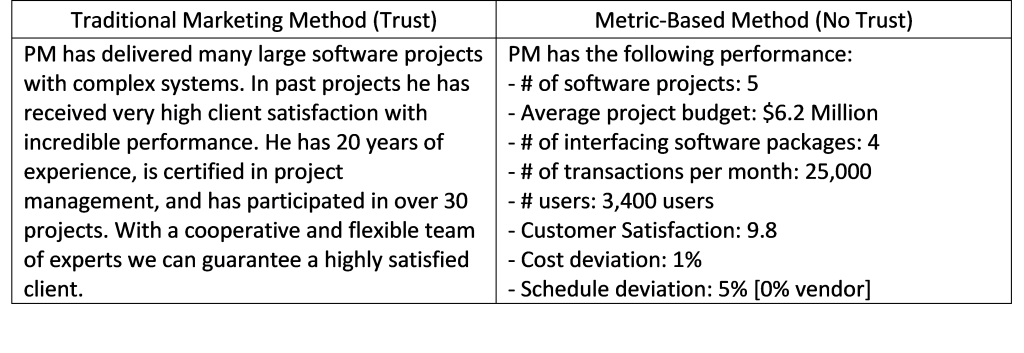
02 Mar Procurement Tip: How Clients Can Rate Million-Dollar Proposals in Less than 30 Minutes
Today’s procurement tip is on how clients can rate million-dollar vendor proposals in less than 30 minutes. There are various procurement methods which use different submittals and rating criteria. In the end, each method shares a common goal which is to identify the best value for the lowest cost. In this article, we will explain five overarching concepts that can be applied to any method you are using which are:
- Have the submittals be nontechnical.
- Have all information be metrics-based and project-specific.
- Focus on the key areas when it comes to submittals: scope, risk and value added.
- Reduce the thinking and decision making with a 1, 5, and 10 rating scale.
- Have a follow-up clarification phase before awarding the project.
Concept 1: Have the vendor’s submittals be nontechnical
A general rule as the buyer is that you do not want to be the expert. You will inevitably have some expertise through your in-house personnel or previous experiences, but you are not the person performing the work. Your goal is to identify an expert that will do the work without any need for micromanagement or constant direction from the you, the buyer. The greater importance you place on the use of the buyer’s expertise, the more you will devalue the vendor’s role and responsibility to be the expert.
For all intents and purposes, the vendor should assume the buyer has no technical expertise. Vendors should be informed that all information passed to the buyer in their submittals should be nontechnical. In others words the buyer’s selection committee should not require any technical expertise to understand and rate the vendor’s proposal. The buyer’s expertise can be used later in procurement when all the technical details will be covered (see Concept 5).
Concept 2: Have all information be metrics-based and project-specific
In traditional procurement processes, it is normal to see vendor submittals to be over 40+ pages. Large proposals like these are filled with excess information that make it harder for the buyer to understand and rate the vendor. Excess information could be:
- Traditional marketing information (fluff) that may look appealing but carries no substance as to the quality or expertise of the vendor.
- Technical information that is unnecessary for the buyer to understand as they are not the ones doing the work or which is not necessary to know this early in the process. Technical information should be simplified to nontechnical information that the buyer can understand.
- Previous projects’ information which are not similar or related to the buyer’s project.
These types of excess information should be eliminated in a vendor’s bid proposal. Any information given should be claims and verifiable performance metrics which support the claim. The information should also be non-technical and come from previous projects which are similar to the buyer’s project. When excess information is excluded and all claims must be supported with project specific performance metrics, submittals can be six pages or less, regardless of the size of the project. See Table 1 as an example of the comparison of traditional vs metrics-based marketing.
Concept 3: Focus on the key areas when it comes to submittals: scope, risk and value added.
There are three main components of a vendor’s proposal to understand which is:
- Scope – the project or service the vendor is proposing.
- Risk – factors which can prevent the vendor from delivering their proposed scope.
- Value added – value outside of the client requirement and vendor proposal that can be added for a change in time, cost, or quality.
All other areas such as product quality, sustainability, productivity, flexibility, and responsiveness can be addressed within these three main components. If done with key Concepts 1 and 2 taken into account [nontechnical, metric based, and project specific], these submittals can each be two pages or less. Through Concepts 1 to 3, the client has severely reduced their time to rate submittals by reducing large vendor proposals to proposals which are no more than six pages.
For more information about identifying experts and incorporating cost as a criterion, see Procurement Tip: How to Sot an Expertv.
Concept 4: Reduce thinking and decision making with a 1, 5, 10 rating scale.
Nothing increases mistakes and vendor protests more than buyer thinking and decision making. Everyone has their own experiences and bias which shape their perception. When selection committee members are forced to think and make decisions, each will naturally resort to using their individual perception which increases the risk of the project. It is harder to defend and substantiate results which are based on an individual’s perception compared to results based on clear and simple evidence. For this reason, it is beneficial to use a 1, 5 and 10 scale when rating submittals.
- A rating of 1 signifies the submittal clearly does not meet the requirement. For example, in the suggested three submittals in Concept 3, it could be that their scope is insufficient, they create risk, or they decrease value to the client.
- A rating of 5 signifies the submittal is unclear if it does or does not meet the requirement, as there is an insufficient description or supporting performance metrics, or the submittal is not understandable to a non-technical selection committee member.
- A rating of 10 signifies the submittal meets the requirement based on descriptions and supporting performance metrics.
Each rating is now very clear and distinct. To justify a “10” rating, there will be clear claims and metrics. To justify a “5” rating, there must be a lack of metrics or information, and to justify a “1” rating, there will be clear examples which show the requirement is not met. In contrast, it becomes more complex when similar ratings are used like acceptable, good, and excellent. For example, if a vendor has an 8.5 customer satisfaction score is this acceptable, good, or excellent? Or what if the ratings of “7” and “8” were used on a scale 1 to 10, what determines the one-point difference? When ratings are not clearly able to be distinguished, it will increase the risk of mistakes and protests due to the buyer’s thinking and decision making.
If Concept 1 to 3 are correctly followed, the client will receive vendor proposals no more than six pages in length which are filled only with non-technical, project specific metric-based claims. In following the rating guidelines provided in Concept 4, the client should now be able to rate and distinguish a vendor’s proposal as easily as they could separate and distinguish oranges from apples.
Concept 5: Have a follow-up clarification phase before awarding the project.
 Once the top vendor is identified, a client should always have a clarification phase before awarding the project. In this clarification meeting it is the vendor’s responsibility is to relay their entire plan and ensure it meets the client’s requirement and expectations. This plan will include a detailed/milestone schedule and any technical documents necessary. This should not be a negotiation phase but the chance for the vendor to clarify any project assumptions, risk, and buyer expectations. If the buyer is satisfied and confirms that the plan matches the vendor’s rated submittals, the project is awarded. By using the clarification phase as a confirmation of the vendor’s submittals, it will allow buyers to exclude the technical details of the vendor’s submittals until they are necessary to be reviewed in the clarification phase. In this manner, both buyer and vendors will save time and resources in rating and bidding for projects.
Once the top vendor is identified, a client should always have a clarification phase before awarding the project. In this clarification meeting it is the vendor’s responsibility is to relay their entire plan and ensure it meets the client’s requirement and expectations. This plan will include a detailed/milestone schedule and any technical documents necessary. This should not be a negotiation phase but the chance for the vendor to clarify any project assumptions, risk, and buyer expectations. If the buyer is satisfied and confirms that the plan matches the vendor’s rated submittals, the project is awarded. By using the clarification phase as a confirmation of the vendor’s submittals, it will allow buyers to exclude the technical details of the vendor’s submittals until they are necessary to be reviewed in the clarification phase. In this manner, both buyer and vendors will save time and resources in rating and bidding for projects.
For more information in confirming the vendor’s proposal see Procurement Tip: Let the vendor Speak First
A Process Which Incorporates All Five Concepts
When all five concepts are used in rating a vendor proposal it should take less than 30 minutes for your selection committee to rate all vendor proposals no matter the project size. The Best Value Approach (BVA) is a procurement and project management process which applies all five of these concepts in a structured procurement process. The BVA has been proven on over 2,000 projects valuing at $6.6B over 30 years with 94% of project finishing on time and on budget. To learn more about the Best Value Approach to procurement and project management here are some additional resources:
- Free membership for latest tips and news: https://pbsrg.com/membership/
- For latest books, events, and licensed partners: https://pbsrg.com/resources/
- Latest BVA journal publications: www.cibw117.org/
- Annual Best Value Conference in January: https://bestvalueconference.ksm-inc.com/
- Latest presentations and videos: https://www.youtube.com/channel/UCxBi26nXLDTqG4ZRV6p0iiQ



